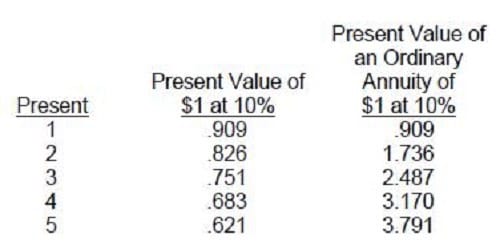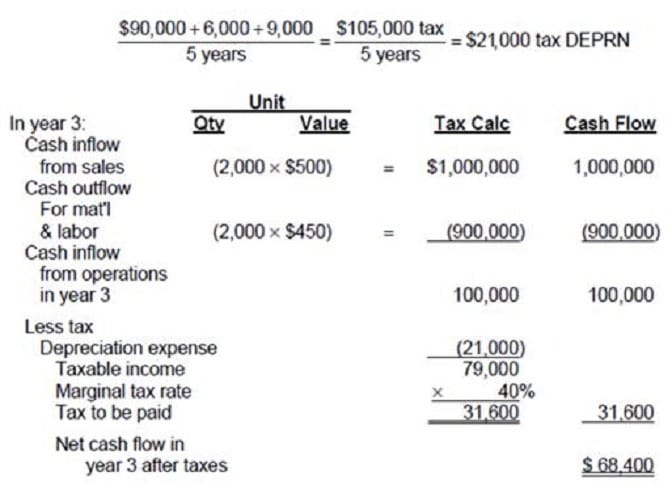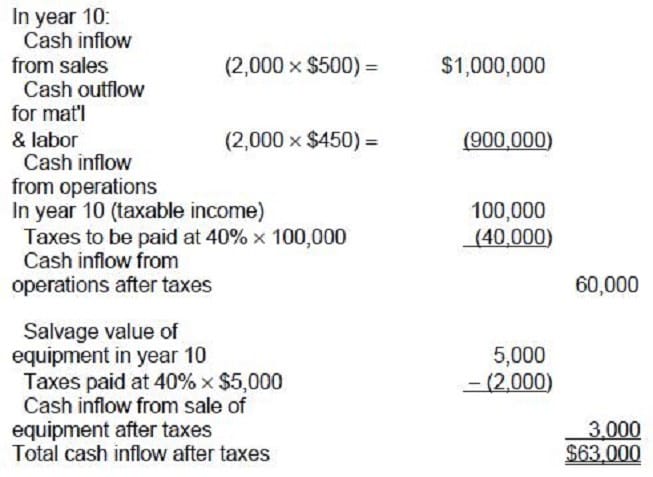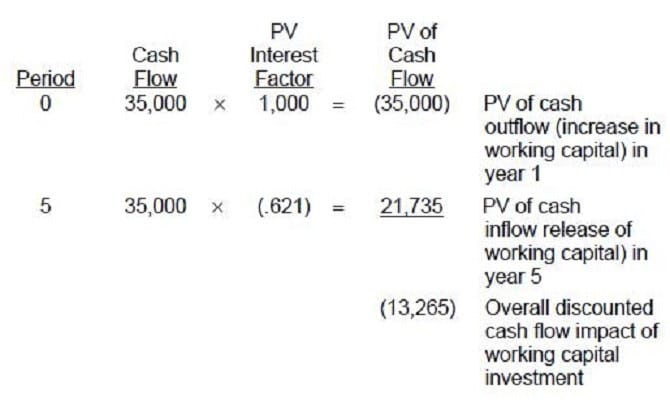Exam Details
Exam Code
:BUSINESS-ENVIRONMENT-AND-CONCEPTSExam Name
:Certified Public Accountant (Business Environment amd Concepts)Certification
:Test Prep CertificationsVendor
:Test PrepTotal Questions
:530 Q&AsLast Updated
:Apr 11, 2025
Test Prep Test Prep Certifications BUSINESS-ENVIRONMENT-AND-CONCEPTS Questions & Answers
-
Question 211:
The capital budgeting model that is generally considered the best model for long-range decision making is the:
A. Payback model.
B. Accounting rate of return model.
C. Unadjusted rate of return model.
D. Discounted cash flow model.
-
Question 212:
Para Co. is reviewing the following data relating to an energy saving investment proposal:

What would be the annual savings needed to make the investment realize a 12% yield?
A. $8,189
B. $11,111
C. $12,306
D. $13,889
-
Question 213:
For the next 2 years, a lease is estimated to have an operating net cash inflow of $7,500 per annum, before adjusting for $5,000 per annum tax basis lease amortization, and a 40% tax rate. The present value of an ordinary annuity of $1 per year at 10% for 2 years is $1.74. What is the lease's after-tax present value using a 10% discount factor?
A. $2,610
B. $4,350
C. $9,570
D. $11,310
-
Question 214:
Pole Co. is investing in a machine with a 3-year life. The machine is expected to reduce annual cash operating costs by $30,000 in each of the first 2 years and by $20,000 in year 3. Present values of an annuity of $1 at 14% are:

Using a 14% cost of capital, what is the present value of these future savings?
A. $59,600
B. $60,800
C. $62,900
D. $69,500
-
Question 215:
An advantage of the net present value method over the internal rate of return model in discounted cash flow analysis is that the net present value method:
A. Computes a desired rate of return for capital projects.
B. Can be used when there is no constant rate of return required for each year of the project.
C. Uses a discount rate that equates the discounted cash inflows with the outflows.
D. Uses discounted cash flows whereas the internal rate of return model does not.
-
Question 216:
The Moore Corporation is considering the acquisition of a new machine. The machine can be purchased for $90,000; it will cost $6,000 to transport to Moore's plant and $9,000 to install. It is estimated that the machine will last 10 years, and it is expected to have an estimated salvage value of $5,000. Over its 10year life, the machine is expected to produce 2,000 units per year with a selling price of $500 and combined material and labor costs of $450 per unit. Federal tax regulations permit machines of this type to be depreciated using the straight-line method over 5 years with no estimated salvage value. Moore has a marginal tax rate of 40 percent.
What is the net cash flow for the third year that Moore Corporation should use in a capital budgeting analysis?
A. $68,400
B. $64,200
C. $53,700
D. $47,400
-
Question 217:
The Moore Corporation is considering the acquisition of a new machine. The machine can be purchased for $90,000; it will cost $6,000 to transport to Moore's plant and $9,000 to install. It is estimated that the machine will last 10 years, and it is expected to have an estimated salvage value of $5,000. Over its 10year life, the machine is expected to produce 2,000 units per year with a selling price of $500 and combined material and labor costs of $450 per unit. Federal tax regulations permit machines of this type to be depreciated using the straight-line method over 5 years with no estimated salvage value. Moore has a marginal tax rate of 40 percent.
What is the net cash flow for the tenth year of the project that Moore Corporation should use in a capital budgeting analysis?
A. $81,000
B. $68,400
C. $63,000
D. $60,000
-
Question 218:
Under which one of the following conditions is the internal rate of return method less reliable than the net present value technique?
A. When the net present value of the project is equal to zero.
B. When income taxes are considered in the analysis.
C. When both benefits and costs are included, but each is separately discounted to the present.
D. When there are several alternating periods of net cash inflows and net cash outflows.
-
Question 219:
In order to increase production capacity, Gunning Industries is considering replacing an existing production machine with a new technologically improved machine effective January 1, 1997. The following information is being considered by Gunning Industries.
•
The new machine would be purchased for $160,000 in cash. Shipping, installation, and testing would cost an additional $30,000.
•
The new machine is expected to increase annual sales by 20,000 units at a sales price of $40 per unit. Incremental operating costs are comprised of $30 per unit in variable costs and total fixed costs of $40,000 per year.
•
The investment in the new machine will require an immediate increase in working capital of $35,000.
•
Gunning uses straight-line depreciation for financial reporting and tax reporting purposes. The new machine has an estimated useful life of five years and zero salvage value.
•
Gunning is subject to a 40 percent corporate income tax rate.
Gunning uses the net present value method to analyze investments and will employ the following factors and rates.

The overall discounted cash flow impact of Gunning Industries' working capital investment for the new production machine would be:
A. $(7,959)
B. $(10,680)
C. $(13,265)
D. $(35,000)
-
Question 220:
The Moore Corporation is considering the acquisition of a new machine. The machine can be purchased for $90,000; it will cost $6,000 to transport to Moore's plant and $9,000 to install. It is estimated that the machine will last 10 years, and it is expected to have an estimated salvage value of $5,000. Over its 10year life, the machine is expected to produce 2,000 units per year with a selling price of $500 and combined material and labor costs of $450 per unit. Federal tax regulations permit machines of this type to be depreciated using the straight-line method over 5 years with no estimated salvage value. Moore has a marginal tax rate of 40 percent. What is the net cash outflow at the beginning of the first year that Moore Corporation should use in a capital budgeting analysis?
A. $(85,000)
B. $(90,000)
C. $(96,000)
D. $(105,000)
Related Exams:
AACD
American Academy of Cosmetic DentistryACLS
Advanced Cardiac Life SupportASSET
ASSET Short Placement Tests Developed by ACTASSET-TEST
ASSET Short Placement Tests Developed by ACTBUSINESS-ENVIRONMENT-AND-CONCEPTS
Certified Public Accountant (Business Environment amd Concepts)CBEST-SECTION-1
California Basic Educational Skills Test - MathCBEST-SECTION-2
California Basic Educational Skills Test - ReadingCCE-CCC
Certified Cost Consultant / Cost Engineer (AACE International)CGFM
Certified Government Financial ManagerCGFNS
Commission on Graduates of Foreign Nursing Schools
Tips on How to Prepare for the Exams
Nowadays, the certification exams become more and more important and required by more and more enterprises when applying for a job. But how to prepare for the exam effectively? How to prepare for the exam in a short time with less efforts? How to get a ideal result and how to find the most reliable resources? Here on Vcedump.com, you will find all the answers. Vcedump.com provide not only Test Prep exam questions, answers and explanations but also complete assistance on your exam preparation and certification application. If you are confused on your BUSINESS-ENVIRONMENT-AND-CONCEPTS exam preparations and Test Prep certification application, do not hesitate to visit our Vcedump.com to find your solutions here.







